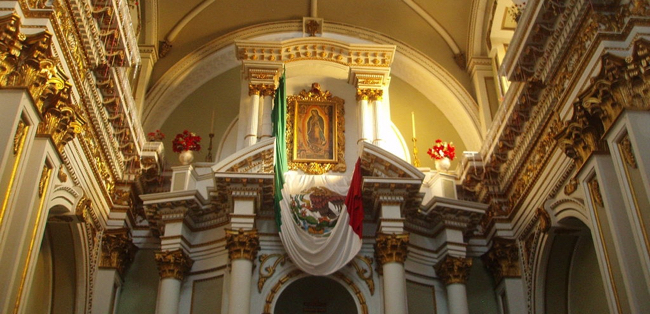
The interior of the Colima Cathedral, in Mexico. Note: The Colima Cathedral was the first Catholic church in Latin America to be consecrated to the Virgin of Guadalupe, though it does not house the tilma of Juan Diego and is not the famed Catholic pilgrimage site. Photo courtesy of Wikimedia Commons
WEDNESDAY, DECEMBER 12: Catholic accounts state that on the morning of Dec. 9, 1531, the peasant Juan Diego saw an apparition of a young girl at the Hill of Tepeyac, near Mexico City: today, the series of miracles that followed are recalled on the feast of Our Lady of Guadalupe.
On Dec. 12, 1531—three days after the first apparition sighting—Juan Diego opened his cloak before a local bishop, and an image of Our Lady that is still vivid today was imprinted inside. The apparitions seen by Juan Diego bridged a gap between the natives’ belief systems and the Catholic religion, and in centuries since, the image of Our Lady of Guadalupe has been cherished across Mexico and in parts of Latin America.
THE APPARITION & THE TILMA
According to Catholic tradition: On the morning of December 9, 1531, Juan Diego was on his way to Mass. While walking, Juan Diego spotted a young girl at the Hill of Tepeyac; the girl spoke to him in his native language, Nahuatl, and asked that a church be built at the site, in her honor. Based on her words, Juan Diego recognized the girl as the Virgin Mary.
Did you know? Peasant Juan Diego was canonized in 2002.

Pilgrims at the Basilica of Our Lady of Guadalupe, in Mexico City. Each year on or before December 12, pilgrims arrive—some even crawl on their knees for miles as they approach the basilica. Photo by Geraint Rowland, courtesy of Flickr
When Juan Diego approached Spanish Archbishop Fray Juan de Zumarraga, the archbishop asked for proof of the apparition’s identity. The apparition then instructed Juan Diego to gather out-of-season Castilian roses from a hilltop, and to revisit the archbishop. Juan Diego opened his cloak before the archbishop, letting the roses fall to the floor—and there, on the inside of the tilma (cloak), was an image of the Virgin of Guadalupe.
According to Catholic sources, several miracles have been associated with Juan Diego’s tilma through the centuries, including the tilma itself: with its construction of coarse cactus fiber, the tilma should have degraded hundreds of years ago. The colors forming the image of Our Lady are as yet unidentified, and in 1951, photographers discovered reflections in the Virgin’s eyes that identify the individuals present at Juan Diego’s unveiling. Studies have revealed that the stars in Mary’s mantle match what would have been seen in the Mexican sky in December of 1531.
MILLIONS FLOCK TO PILGRIMAGE SITE
The Virgin Mary has been deemed the “Queen of Mexico,” and in 1945, Pope Pius XII declared her the the Empress of all the Americas. Currently, the Basilica of Our Lady of Guadalupe (grounds shown, at right) competes for the most visited Catholic pilgrimage destination in the world.
A MEXICAN MENU, GUADALUPE HYMNS AND MORE
Catholics everywhere can honor Our Lady of Guadalupe with a novena, or with a Mexican dinner in honor of Juan Diego and the basilica. (Find easy recipes and decoration ideas at Catholic Cuisine, and a recipe for Mexican lentil soup at The Catholic Foodie. For novenas and more, visit CatholicCulture.org.) Beef broth, flan, Mexican bread pudding and mole poblano—finished with café con leche—could all contribute to a dinner feast for the occasion.